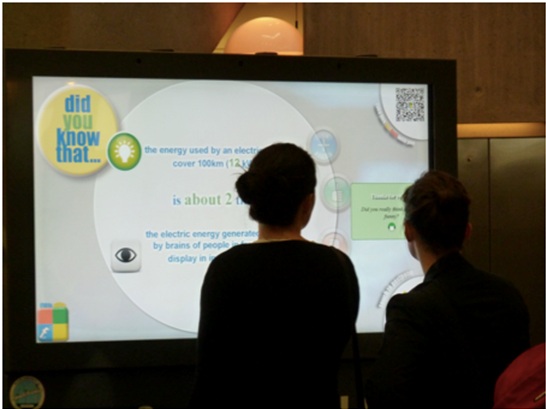Open Display Networks: A Communications Medium for the 21st Century

Related topics
Future and emerging technologies Germany Portugal United Kingdom Switzerland FET Opendate: 01/05/2014
Project: Towards Future Pervasive Display Network...
acronym: PD-NET
See also: CORDIS
Contact: Contact
The creation of this new communications medium requires significant innovation that can only occur through opening display networks to applications and content from a wide range of sources.
The PD-NET project tackled the scientific challenge of creating open pervasive display networks in areas as diverse as user interaction with future public displays, support for personalization of displays while preserving user privacy, the design of scheduling and communications components for global display networks and the creation of displays that generate their own content to display. The project members reported their work in over fifty academic publications.
The project also engineered a series of building blocks for future display networks and developers can access the project’s API framework and obtain open source implementations of some of the project key signage components. These building blocks were tested as part of major signage test-bed that included displays in Europe and North America. To support these deployments the project team created a rich ethics process to ensure the research into public displays met with the highest ethical requirements. This ethics process has also been published.
Since the project finished in the summer of 2013, the project team have continued to be very busy. Members of the team in Portugal have created a startup, called DISPLR, to explore the business potential of open display networks. DISPLR aims to create a disruptive global service for public displays that will challenge some of the most prevailing assumptions behind Digital Signage systems. The company has so far managed to secure the necessary seed funding for the first 2 years, including an R&D grant from the Portuguese Government, and is now preparing the next round of funding, which will mainly target strategic international partners.
Development of the open source components has also continued and at PerDis 2014 (3rd International Symposium on Pervasive Displays, 3-4 June, Copenhagen) the team will demonstrate, for the first time, a complete software system for open display networks.
For example, this system is now deployed in two UK schools as the project members look to build a critical mass of open displays in the education sector. At school, the displays are used to share pictures of children’s work. The project members wrote an iPad app that let the teachers easily take photos of the children’s work and activities and then publish them to screens in both their own school and, if they want to, a second school or a public web site. The screens are in the school halls so the kids can reflect on what they have done. It’s been up and running a few weeks and the feedback is really good so far!
The PD-NET project, coordinated by Lancaster University (UK), was funded under FET-Open scheme for a period of 39 months (from 01/05/2010 to 31/07/2013), with European Commission contribution of 1.446.029 €.
